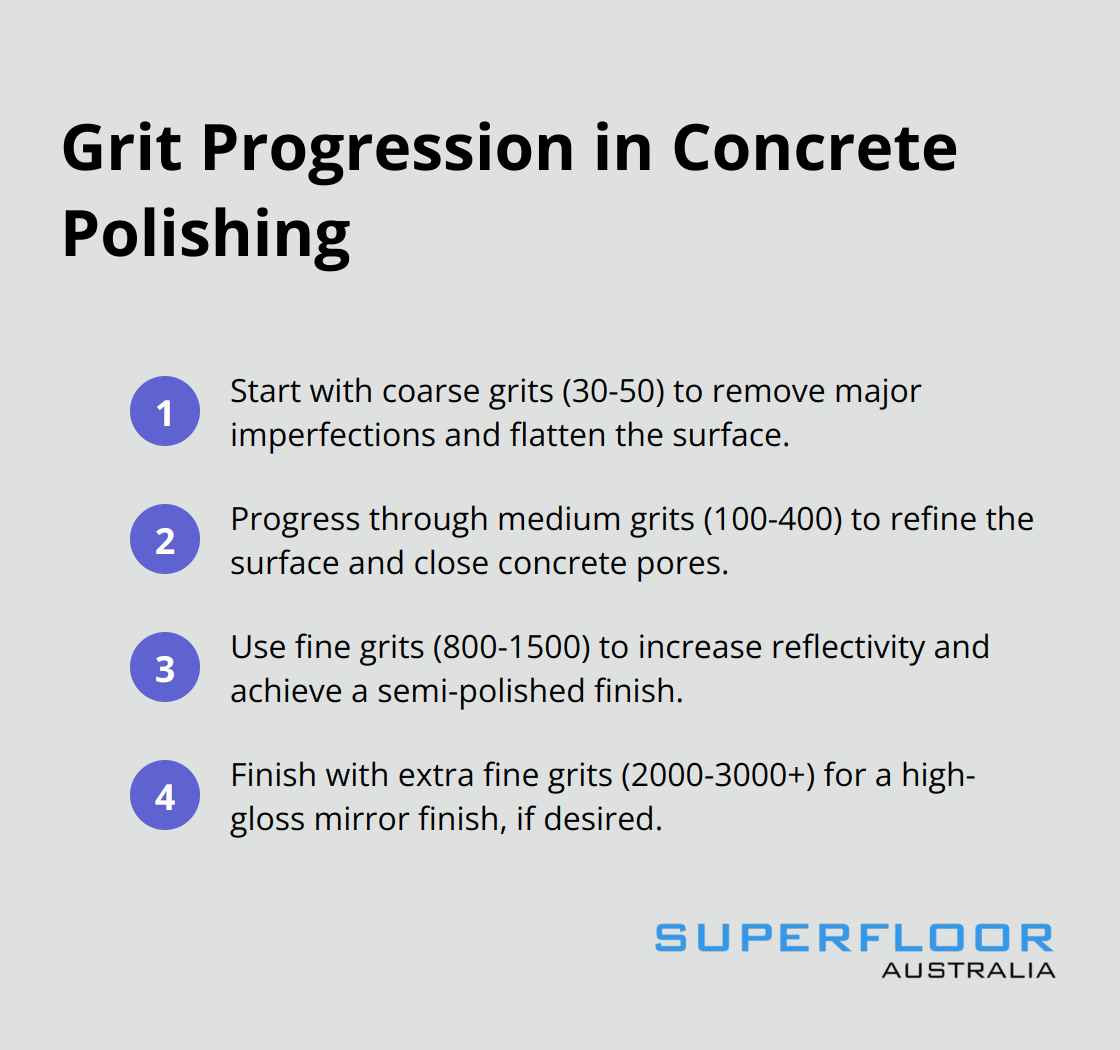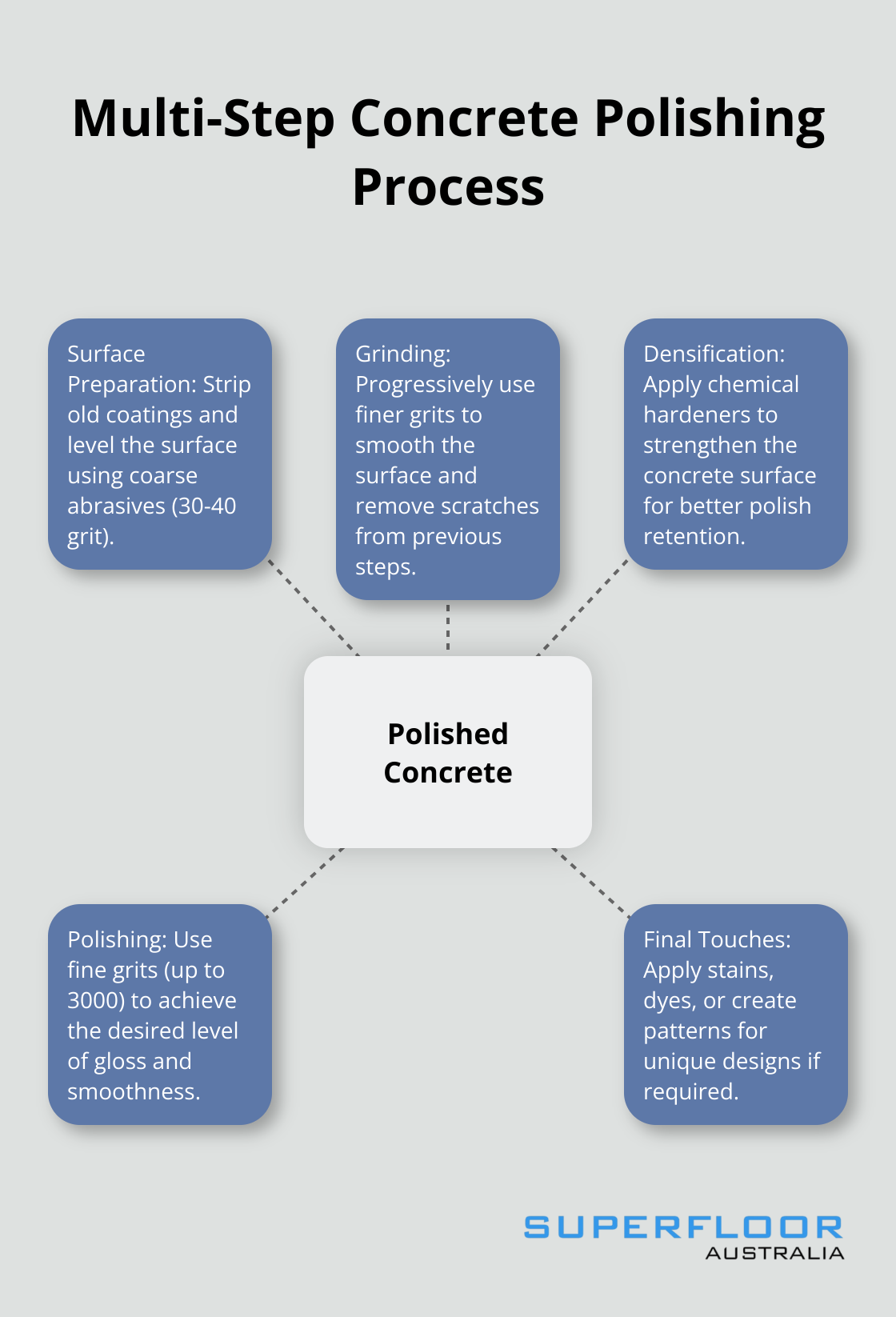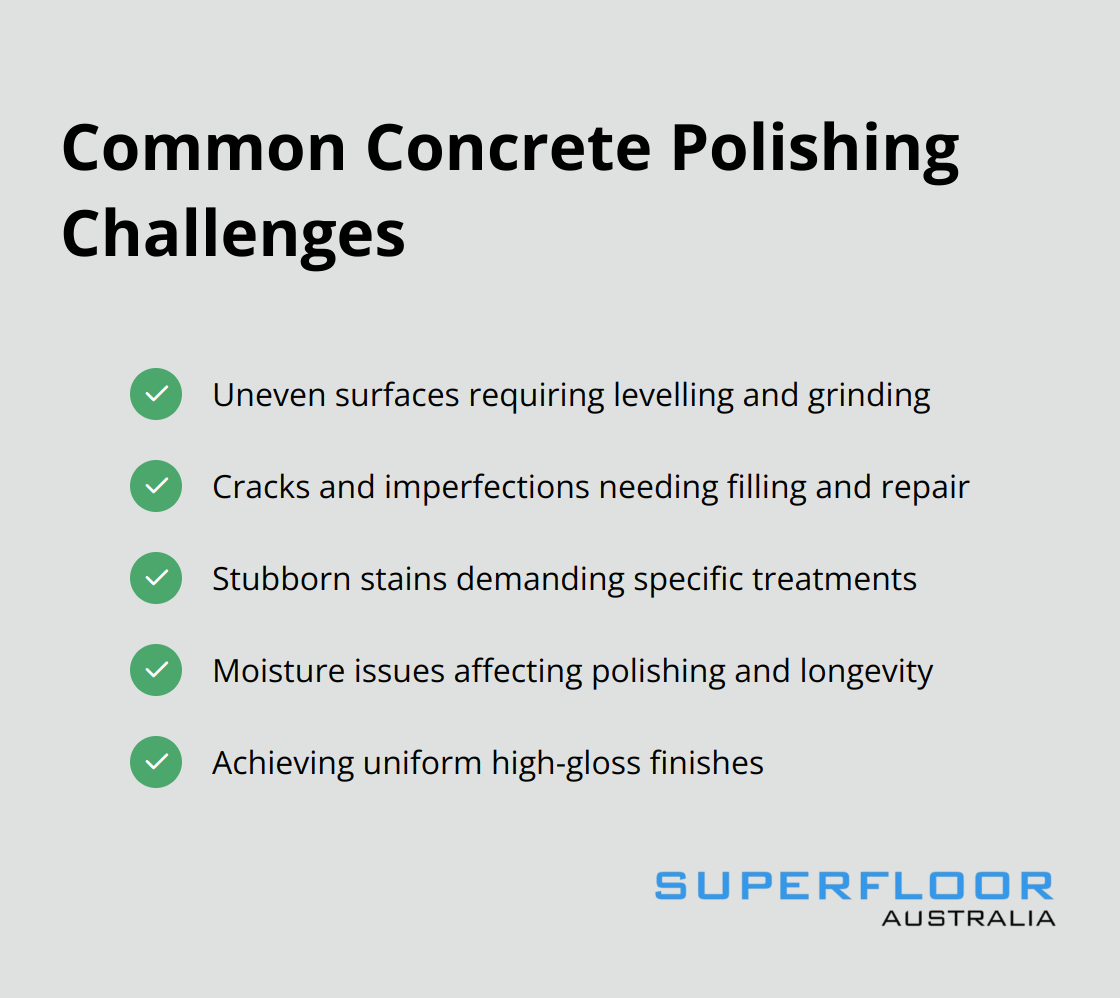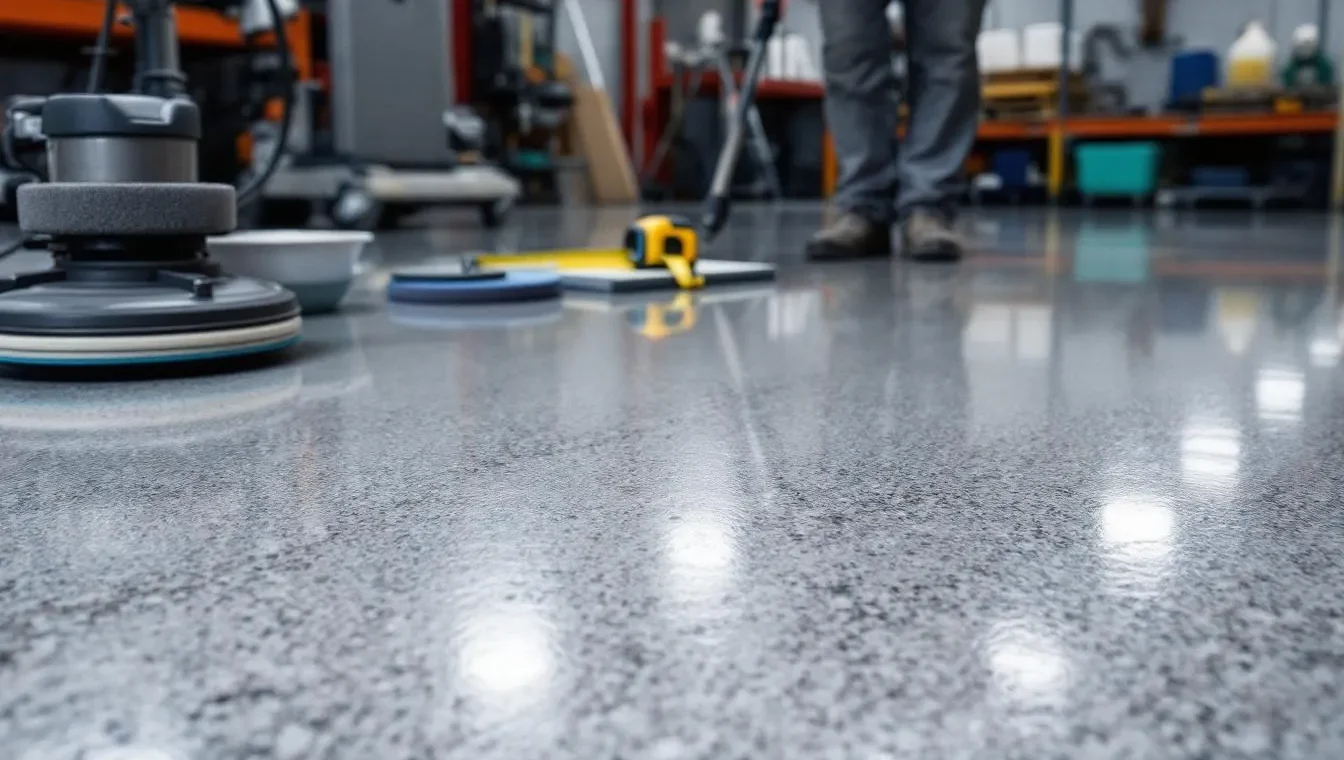At Superfloor Australia, we’ve mastered the art of advanced concrete polishing through years of experience and continuous innovation.
Concrete polishing has evolved from a simple finishing technique to a complex process that requires in-depth knowledge and specialised skills.
This blog post will guide you through the intricacies of advanced concrete polishing techniques, from understanding the science behind the process to troubleshooting common issues.
What Makes Concrete Polishing Unique?
The Chemistry of Concrete
Concrete polishing transforms ordinary surfaces into durable, aesthetically pleasing floors. This process involves a complex interplay of chemistry and physics. Concrete primarily consists of cement, water, and aggregates. When mixed, these components undergo hydration, forming calcium silicate hydrate (C-S-H) crystals. These crystals provide concrete with its strength and durability.
The calcium hydroxide (CH) content, a byproduct of cement hydration, can weaken the surface if left untreated. To address this, we use densifiers (typically sodium, potassium, or lithium silicates) to convert CH into more C-S-H. This conversion strengthens the surface and improves its ability to take a polish.
Abrasives: The Tools of the Trade
Abrasives play a crucial role in concrete polishing. They come in various forms, from metal-bonded diamonds for initial grinding to resin-bonded diamonds for finer polishing. The effectiveness of abrasives depends on factors like bond hardness, diamond concentration, and grit size.
Selecting the right abrasive for each polishing stage is essential. Softer concrete requires harder-bonded abrasives to prevent excessive wear, while harder concrete needs softer-bonded tools to ensure effective material removal.
The Grit Progression
The grit size of abrasives significantly influences the desired finish. The process typically starts with coarse grits (30-50) to remove major imperfections and flatten the surface. As the process progresses through finer grits (100-3000+), it gradually refines the surface, closes the concrete’s pores, and increases its reflectivity.
Each grit leaves microscopic scratches on the surface. The key is to ensure that each subsequent grit removes the scratches left by the previous one. Skipping grits can result in a subpar finish, as deeper scratches may remain visible even after finer polishing.
The final grit used determines the level of gloss. For a matte finish, the process might stop at 400 grit, while a high-gloss mirror finish could require grits up to 3000 or higher (depending on the client’s preferences and the concrete’s characteristics).

Understanding these scientific principles allows for a tailored approach to each unique concrete surface. Mastering the interplay between concrete chemistry, abrasive properties, and grit progression consistently delivers superior polished concrete floors that meet and exceed expectations.
As we move forward, let’s explore the advanced polishing techniques that build upon this scientific foundation to create truly exceptional concrete surfaces.
Advanced Polishing Techniques: Mastering the Art
Multi-Step Polishing Process
At Superfloor Australia, we employ a meticulous multi-step process for concrete polishing. Professionals start with coarse tools to eliminate imperfections, then gradually refine surfaces. Coarser abrasives (like 30-40 grit) strip away old coatings, and the process continues with progressively finer grits. This methodical approach eliminates deep scratches from previous steps and ensures a smooth transition.

Wet vs. Dry Polishing: Choosing the Right Method
The choice between wet and dry polishing depends on various factors. Dry polishing concrete has significant advantages over wet polishing procedures. It allows preparatory grinding and polishing to take place in a tiered system. Dry polishing works particularly well for harder concrete and allows better visibility of the surface during polishing. Wet polishing, however, has its advantages, especially when dealing with softer concrete or when dust control is a priority.
Wet polishing keeps the diamonds cooler, potentially extending their life. However, it requires more cleanup and can slow down the process. We often use a combination of both methods, starting dry for initial grinding and switching to wet for finer grits to achieve optimal results.
Achieving High-Gloss Finishes
The path to a high-gloss finish requires patience and precision. After completing the grinding steps (typically up to 400 grit), we apply a densifier to harden the surface. This step is essential for achieving and maintaining a high shine. We then continue with finer grits, often going up to 3000 or even 5000 for an ultra-high gloss.
The key to a lasting high-gloss finish lies in proper densification. We apply multiple coats of densifier, allowing each to penetrate and react fully before moving to the next polishing step. This process can take several days but results in a harder, more durable surface that maintains its shine for an extended period.
Creating Unique Designs
Polished concrete offers various design options to make your floor unique. One popular technique involves the use of dyes or stains applied before the final polishing steps. These can create vibrant colours or subtle earth tones, depending on your preference.
Texture patterns can be created in the floor surface by using stencils to mask areas of the concrete before the retardant is applied. The protected areas remain untouched, creating unique designs. For more intricate designs, we use saw-cutting techniques to create patterns or logos. These cuts are filled with epoxy in contrasting colours before the final polish, resulting in a seamless, professional look. Another option exposes aggregate through controlled grinding, revealing the natural beauty of the stones within the concrete.
As we move forward, it’s important to address common issues that may arise during the polishing process. Let’s explore how to troubleshoot these challenges and ensure a flawless finish.
Tackling Common Concrete Polishing Challenges
At Superfloor Australia, we’ve overcome numerous obstacles in our concrete polishing projects. Let’s explore some common issues and their solutions.

Uneven Surfaces: Levelling the Playing Field
Uneven concrete surfaces hinder uniform polish, especially in older buildings or poorly laid concrete. We use a floor grinder with metal-bonded diamond segments to level the surface. For severely uneven floors, we start with 30/40 grit diamonds, then progress to finer grits up to 100/200. This process ensures a perfectly level surface for subsequent polishing steps.
In extreme cases, we use self-levelling compounds to address major unevenness. However, this method requires careful consideration as it can affect the final appearance and durability of the polished concrete.
Cracks and Imperfections: More Than Skin Deep
Cracks and imperfections in concrete compromise the integrity of the polished surface. Our standard procedure involves cleaning the cracks thoroughly, then filling them with a high-quality epoxy or polyurea filler. For hairline cracks, we often use a concrete mender, which penetrates deeply and bonds the concrete.
Stubborn Stains: The Persistent Problem
Stains (particularly oil, rust, and organic) often require specific treatments. For oil stains, we use a poultice method, applying a baking soda paste directly onto the stain, ensuring a uniform layer about 1/4 inch deep, and allowing it to dry completely. Rust stains often respond well to a combination of phosphoric acid and manual scrubbing.
Moisture Issues: The Hidden Threat
Moisture-related problems impact the polishing process and the longevity of the finished floor. We always conduct moisture testing before starting a project. For concrete with high moisture content, we might recommend a moisture mitigation system to limit the impact of moisture on installed floors and reduce the risks of moisture-related problems.
In a recent commercial project, we encountered high moisture levels in a newly poured slab. We applied a specialised epoxy moisture barrier before proceeding with the polishing process. This extra step added to the project timeline but ensured the long-term success of the polished floor.
Addressing these common issues requires a combination of experience, technical knowledge, and the right tools. We continuously update our techniques and equipment to tackle even the most challenging concrete polishing projects effectively.
Final Thoughts
Advanced concrete polishing techniques require continuous learning and refinement. We explored the science behind concrete composition, the role of abrasives, and the impact of different grits on surface finish. Our multi-step polishing process, combined with strategic choices between wet and dry methods, allows us to achieve stunning high-gloss finishes and create unique designs.
Addressing challenges like uneven surfaces, cracks, stubborn stains, and moisture issues demands a deep understanding of concrete properties and innovative problem-solving approaches. These skills develop through years of hands-on experience and a commitment to staying current with industry advancements. The future of concrete polishing technology promises more environmentally friendly processes, advanced densifiers, and innovative design techniques.
At Superfloor Australia, we deliver exceptional polished concrete flooring in Brisbane. Our expertise in advanced concrete polishing techniques allows us to create stunning, long-lasting surfaces for residential, commercial, and industrial spaces (combining precision preparation, expert craftsmanship, and cutting-edge technology). We remain committed to pushing the boundaries of what’s possible in concrete polishing.
